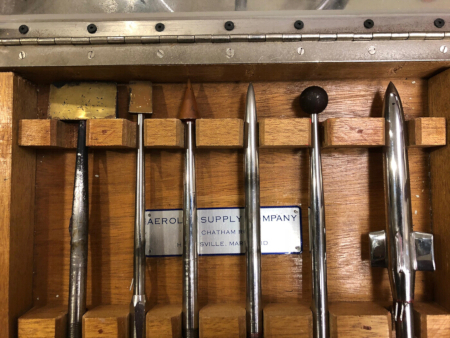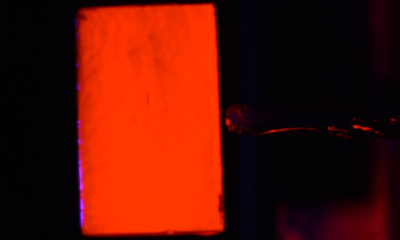Visualización del flujo de tinte superficial: Un método cualitativo para observar los patrones de las líneas del tramo en un flujo supersónico
Visión general
La visualización de flujo alrededor o en un cuerpo es una herramienta importante en la investigación aerodinámica. Proporciona un método para estudiar cualitativa y cuantitativamente la estructura de flujo, y también ayuda a los investigadores a teorizar y verificar el comportamiento del flujo de fluidos. La visualización de flujo se puede dividir en dos categorías: visualización fuera de la superficie y visualización de flujo de superficie. Las técnicas de visualización de flujo fuera de la superficie implican determinar las características de flujo alrededor del cuerpo de interés. Incluyen pero no se limitan a la velocimetría de imágenes de partículas (PIV), la imagen Schlieren y la visualización del flujo de humo. Estas técnicas pueden proporcionar datos cualitativos y cuantitativos sobre el flujo alrededor de un cuerpo. Sin embargo, estas técnicas son generalmente costosas y difíciles de configurar. Las técnicas de visualización del flujo de superficie, por otro lado, implican el recubrimiento del cuerpo de interés con un tinte para estudiar el flujo en la superficie. Estas técnicas, que son más invasivas en la práctica, incluyen la visualización del flujo de tinte y, más recientemente, utilizar pintura sensible a la presión, que da una imagen detallada del flujo en la superficie del cuerpo. Esto permite a los investigadores visualizar diferentes entidades de flujo, incluidas burbujas laminares, transiciones de capa de contorno y separación de flujo. La visualización del flujo de tinte, la técnica de interés en el experimento actual, proporciona una imagen cualitativa del flujo de superficie y es uno de los métodos de visualización de flujo de superficie más simples y rentables, específicamente para visualizar flujos gaseosos en un Cuerpo.
En este experimento, el comportamiento del flujo de superficie en seis cuerpos se estudia en flujo supersónico. Los patrones de raya se obtienen utilizando la técnica de visualización del flujo de colorante, y las trayectorias de flujo, el grado de unión y separación del flujo, y la ubicación y el tipo de choques se identifican y estudian a partir de las imágenes de flujo.
Procedimiento
-
Observando esrayas en el flujo supersónico
- Mezcle el polvo de colorante fluorescente y el aceite mineral en un recipiente de plástico. Añadir pequeñas cantidades de aceite mineral al tinte en incrementos, mezclando continuamente hasta obtener una mezcla semi-viscosa. La mezcla no debe ser moquea.
- Monte el aguijón por encima de la cámara de prueba del túnel de viento supersónico y enciérrelo en su lugar. En esta demostración se utilizó un túnel de viento supersónico de soplado con una sección de pru
Resultados
A continuación se muestran los patrones de flujo de línea de raya para los seis modelos y condiciones enumerados en la Tabla 1. Para la cuña 2D, se observa un patrón de flujo uniforme sobre el cuerpo, como se muestra en la Figura 4,excepto en la región donde hay una deformidad de superficie, lo que hace que el flujo se separe. Cuando se inclina a12o,el flujo a lo largo de la superficie se desvía hacia arriba. Este efecto se refleja cuando el modelo está en ángulo de-12o.<...
Aplicación y resumen
Los patrones de flujo de raya en seis cuerpos en flujo supersónico se estudiaron utilizando la visualización del flujo de tinte superficial. Los patrones de flujo sobre las cuñas 2D y 3D mostraron que los efectos de la punta desempeñan un papel dominante en la determinación de la estructura de flujo de superficie. Se demostró que el flujo sobre el cono estaba completamente unido para un rango de desviación de 13o. El modelo de nariz contundente fue el primer cuerpo en mostrar una línea de separación clara cuando...
Saltar a...
Vídeos de esta colección:

Now Playing
Visualización del flujo de tinte superficial: Un método cualitativo para observar los patrones de las líneas del tramo en un flujo supersónico
Aeronautical Engineering
4.9K Vistas

Rendimiento aerodinámico en un modelo de avión: El DC-6B
Aeronautical Engineering
8.3K Vistas

Caracterización de la hélice: Variaciones en el paso, el diámetro y el número de palas en el rendimiento
Aeronautical Engineering
26.4K Vistas

Comportamiento de la superficie aerodinámica: Distribución de la presión en un ala Clark Y-14
Aeronautical Engineering
21.1K Vistas

Rendimiento del ala Clark Y-14: Despliegue de dispositivos de elevación alta (Flaps y Slats)
Aeronautical Engineering
13.4K Vistas

Método esfera de turbulencia: Evaluación de la calidad del flujo del túnel de viento
Aeronautical Engineering
8.7K Vistas

Flujo cilíndrico transversal: medición de la distribución de la presión y estimación de los coeficientes de arrastre
Aeronautical Engineering
16.2K Vistas

Análisis de boquillas: variaciones en el número de Mach y la presión a lo largo de una boquilla convergente y una convergente-divergente
Aeronautical Engineering
37.9K Vistas

Fotografías de Schlieren: Una técnica para visualizar las características del flujo supersónico
Aeronautical Engineering
11.6K Vistas

Visualización del flujo en un túnel de agua: Observación del vórtice en el borde de ataque sobre un ala Delta
Aeronautical Engineering
8.1K Vistas

Tubo Pitot-estático: Un dispositivo para medir la velocidad del flujo de aire
Aeronautical Engineering
48.9K Vistas

Anemometría de temperatura constante:Uuna herramienta para estudiar el flujo de capa de límite turbulenta
Aeronautical Engineering
7.2K Vistas

Transductor de presión: Calibración mediante un tubo de Pitot estático
Aeronautical Engineering
8.5K Vistas

Control de vuelo en tiempo real: calibración de sensores integrados y adquisición de datos
Aeronautical Engineering
10.2K Vistas

Aerodinámica de multicópteros: Caracterización del empuje en un hexacóptero
Aeronautical Engineering
9.1K Vistas
ACERCA DE JoVE
Copyright © 2025 MyJoVE Corporation. Todos los derechos reservados


